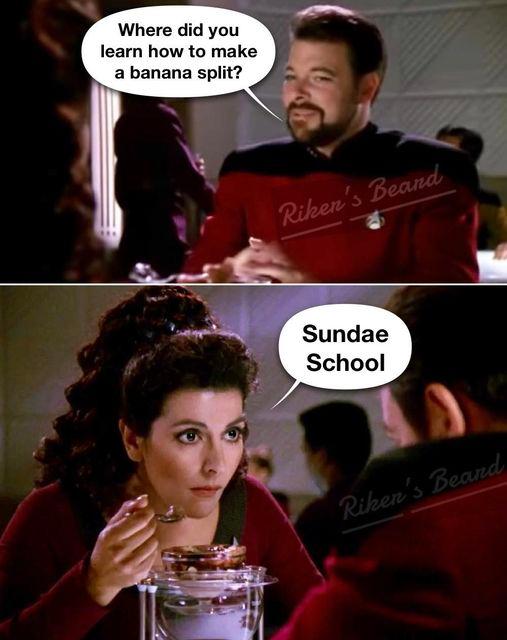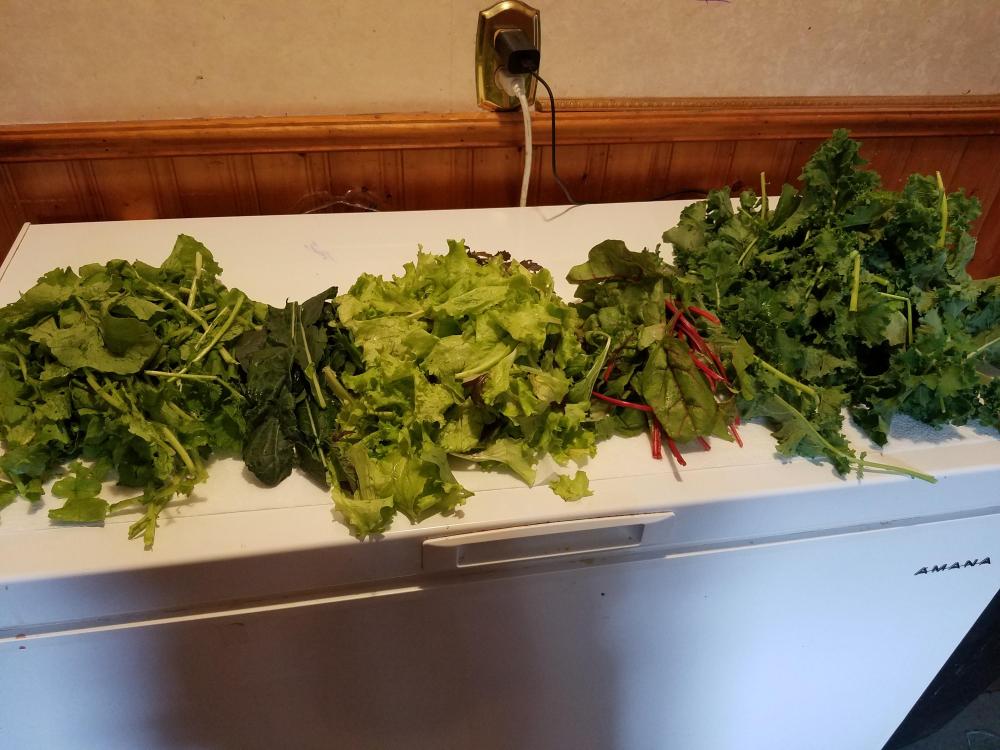-
Posts
6,247 -
Joined
-
Last visited
Content Type
Profiles
Forums
Store
Help Articles
Everything posted by chromedome
-
In the image caption it's described as a "slag tray," which is even funnier. "WTH you usin' that oven for, Jim-Bob?"
-
Truthfully I hadn't even realized we had a separate Prime Day of our own. Which tells you how much the whole thing impacts my likelihood of buying anything.
-
I have dined at homes where three cups of juices could conceivably have been gotten from the bird, because there was definitely no moisture left in its flesh! We know Ann to be an excellent cook, though, so I'd assumed the actual cooking juices were augmented.
-

Airline Food: The good, the bad and the ugly
chromedome replied to a topic in Food Traditions & Culture
I guess this would count as "the ugly"? https://www.theguardian.com/business/2023/jul/10/united-airline-amsterdam-flight-diverted-airplane-food -
That's the very definition of a successful taste test.
-
The term was also used in an earlier movie, The Core, from 2003. A select crew had to pilot an experimental vehicle into the earth's core, which had stopped spinning (go ahead, roll your eyes here, everyone does). The vehicle was, of course, made of "unobtainium" which was the only substance that could handle the crushing pressures. Turned them into energy, in fact. The film doesn't live up to its cast (Hilary Swank, Aaron Eckhart, Delroy Lindo, Stanley Tucci, Richard Jenkins, Bruce Greenwood, Alfre Woodard) but it's entertaining enough in its B-movie way if you're ever hard up for a couple of hours' entertainment.
-
LOL I usually get from the front door to the checkout in 5-10 minutes, unless the aisles are too blocked to move at my normal pace. I try to avoid being at Costco during those times of day.
-
That's not an especially worthy source, as these things go (I declined an offer to write for them because they're so clickbait-y). Yes, high levels of phosphates can result in renal issues (https://www.ncbi.nlm.nih.gov/pmc/articles/PMC3278747/ ) but the likelihood of an occasional Costco chicken causing kidney failure is pretty damned low. And FWIW, phosphate deficiency can also cause problems (https://www.ncbi.nlm.nih.gov/pmc/articles/PMC3402077/ ) so make of that what you will.
-
Here in my neck of the woods, the not-on-sale price for a whole, uncooked chicken at the supermarket is typically $12-$14 (CDN). On sale, it drops down to maybe $7 or $8. Cost of a rotisserie chicken at the same supermarket would be comparable. The rotisserie bird at Costco sells for $7.99 up here, rather than $4.99 (as in the US), but it's a similar bargain in local terms. To my taste it's over-salted, but cooked properly (so it's tender and juicy) while the supermarket rotisserie birds are almost invariably dry. So when I buy one it's a combination of the low price, the convenience and the fact that it's properly cooked. The over-seasoning isn't as obvious after the bird cools, and it's relatively straightforward to correct for in any case. It's not something I buy a lot, but I appreciate it for what it is. Now that we're in the country, and getting home from a shopping trip takes most of an hour, it's nice to bring home something that makes for a quick meal.
-

eG-Inspired Kitchen Gadget Purchases (aka The Enablers' Hall of Fame)
chromedome replied to a topic in Kitchen Consumer
When I was in residence, (cough) years ago, the rumor was that one of my fellow students had succeeded in concealing a microwave in his room for two years by putting a doily and a pair of rabbit ears on top. I never saw this with my own eyes, but it was plausible enough to gain wide credence among us (both microwaves and TVs tended to be large brown boxes in the late 70s). -
Apparently I owe the slugs in my garden a (partial) apology. Looked out my window earlier today and found stepdaughter's mastiff grazing on my bean plants. The electric fence goes back up tomorrow (it rained too much today...again...).
-
Harvested my scapes today, too. May get a pic later. I actually took photos of my garden with the intention of posting them here before I went to NS, but ran out of time and now they're sadly out of date. I'll try to find a few dry hours to get some new photos. I can't currently hill my potatoes or create any new beds because the soil is so sodden, but at least the weeks of wet have been good for weeding. Pulling the little buggers while the soil is wet improves the likelihood of getting them up by the root. It's also been a good few days on "slug patrol." They like the wet, so I've been able to wreak death and destruction on an Old Testament scale within the local gastropod population. They savaged my broccoli beds while I was away, so I was very much in the mood for retribution.
-
First meaningful harvest for me, yesterday. From L to R: Radish greens, Black Magic kale (a Tuscan/"dinosaur"/lacinato variety), mixed salad greens, chard, and Prism kale (a curly variety). Not pictured, the first dozen or so snap peas which disappeared quickly as a snack. The chard and Black Magic went into my GF's dinner, the radish greens went into mine, the salad greens went into the fridge for the next few days' lunches, and the Prism kale was blanched and frozen. The first of many, many bags of greens that will go into my freezer over the next few months.
-
This post combines a couple of my favorites. One of my favorite (lighter weight) CBC radio shows is called Under the Influence, hosted by longtime ad exec Terry O'Reilly, and covers (of course) advertising. Many years ago he ran a campaign for the NB-based Moosehead brewery, and to his surprise Alan Arkin - one of my longtime favorites - stepped up and wanted to do the series of commercials. Turns out he kept a vacation cottage in Cape Breton and drank Moosehead regularly, and was perfectly happy to give them his time for the non-"celebrity spokesperson" budget they'd allocated. Here's a link to O'Reilly's explanation of how it all came about (offered in Arkin's memory), and one of the ads in question. Disclaimer: O'Reilly's "fun story" isn't all that funny, but the ad captures Arkin's dry delivery pretty well (the campaign won industry awards that year in Canada).
-
I would also recommend Craig "Meathead" Goldwyn's site, Amazing Ribs. Underneath the "good ol' boy schtick" he's a serious food writer who delves into the science of barbecue, and has lots of excellent information on technique etc. https://amazingribs.com/
-
Those are very different from the candy sold here under the same name, mainly by NB-based Ganong but also by NS-based Robertson's. The local version is cinnamon candy with a chocolate center (ie the "marrow"). This kind date from 1885. https://ganongchocolatier.shop/products/chicken-bone
-
When I lived in Newfoundland we had a handful of favorite berry patches. The tastiest blackberries were the ones we dubbed the "saber-toothed berries" for their thorns. We wore long-sleeved heavy coats (in the muggy late-summer heat!) to pick them. ...after doing a quick "bear check," of course, to ensure that we were the only ones harvesting at the moment. Bears know a good berry when they find it, too.
-
I've tried and failed to grow it both indoors and outdoors, which irritated me greatly. It's a bloody weed, why would it not grow! Grrr. DIdn't get any seeds this year, but plan to try again next spring.
-
I just Googled it. It's been a few years, I have no idea which recipe I used.
-
So would Chromedome. I make that kind of salad a lot, especially in winter when the salad greens at the supermarket are poor. I've had minimal success growing collards here, but I harvest chard, beet greens, turnip greens, radish greens, and usually 2-4 kinds of kale in any given gardening season. I eat a LOT of greens, as you may guess. Two years ago I did very well at my community garden and had over 30 lbs blanched and frozen for the winter. Last year was unsettled because of our move, and all of the family turmoil with my mother-in-law passing, my GF being crippled with arthritis, and of course being treated for cancer myself (it was quite a year!) so I didn't manage nearly that much. I'm optimistic that this year will be much better on that front. I like a lot of 'em just blanched briefly and then sauteed for a minute or two with garlic and onions. I like pungent greens with sesame seeds, kale in soups and bean dishes, and baby kale just in salads. I've used my garden greens in lieu of grape leaves to make quasi-dolmas. I've even made the Provençal tart with apples, chard and raisins (it was better than you might imagine). That's just off the top of my head. It's been a busy day of visiting (currently at my mom's nursing home, waiting to video-chat with my nephew and his family out in BC).
-
https://www.theguardian.com/world/2023/jun/27/pompeii-fresco-find-possibly-depicts-2000-year-old-form-of-pizza
-
I'm in the "roll out of bed and eat immediately" camp, but my usual breakfast is already-prepared steel-cut oats so prep is 1 minute and 40 seconds in the microwave. Boring and not photogenic, which is why I seldom participate in the breakfast thread. My GF is a late sleeper by inclination and work schedule, so she's up at noon and ready to contemplate food by 8PM or thereabouts. So any kind of elaborate breakfast is a very occasional thing done with the grandkids. Waffles and suchlike.
-
Weirdly, here in Atlantic Canada, a significant minority insist that it's "just not chili" without olives in it. Usually the most generic, pimento-stuffed kind. I don't get it.







